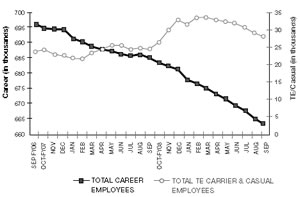Chapter 3 Our Workforce
During 2007, agreements were achieved through the collective bargaining process and through consultation with the management associations to reduce the Postal Service’s share of contributions to the cost of health benefits premiums for its employees. Reductions began in January 2008 for employees represented by the American Postal Workers Union and National Postal Mail Handlers Union and for EAS employees. Reductions begin in January 2009 for employees represented by the National Association of Letter Carriers, the National Rural Letter Carriers’ Association, and the Fraternal Order of Police.
Injury Compensation
The Postal Service continues to work closely with the Office of Workers’ Compensation Programs (OWCP) to place injured employees who cannot be accommodated within the Postal Service into private sector employment. These efforts have resulted in private sector placements, employee retirements, or reductions in compensation payments for 271 former employees. Since the inception of the Vocational Rehabilitation Process in 2003, compensation costs have been reduced by more than $26.5 million annually.
This year the Postal Service saw an increase of 6 percent in workers’ compensation chargeback expenses from the Department of Labor OWCP despite continued decreases in illness, injuries, and accidents. The cash payout totaled over $1 billion.
In an effort to reduce workers’ compensation medical costs, the Postal Service continued two initiatives: the Pharmacy Card Program and the Medical Cost Management Initiative. The Pharmacy Card Program results in discounted prescription prices for the Postal Service and avoids employees paying out-of-pocket expenses and waiting for reimbursements. A savings of $5.6 million was achieved. The Medical Cost Management Initiative was launched in 2005 to identify and recover medical overpayments made to providers. Since the start of the program, OWCP began contracting with an outside company to process medical invoices. This change resulted in a decrease in duplicate payments, but an increase in systemic issues creating overpayments to providers. Working in collaboration with OWCP to correct the issues has resulted in a cost avoidance of $3.5 million per year. Monetary gain from pursuit of third-party claims and overpayments are credited to the Postal Service by OWCP. Ongoing efforts with the Credit Recovery program attained $40.5 million as of August.
The National Reassessment Process (NRP) is a key initiative that reviews the status of employees in rehabilitation and limited-duty assignments at the end of each year. The process ensures that every evaluated employee is placed in an appropriate and necessary work position. NRP was successful in three pilot sites — New York Metro, San Diego, and Western New York — with an additional 53 sites now implementing this initiative. The number of employees in rehabilitation and limited duty assignments was reduced to 31,044, resulting in cost-savings of $146 million this year.
Labor Relations
Collective Bargaining and Consultation
The Postal Service has nine collective bargaining agreements with seven unions covering career employees. Negotiations with unions cover wages, many benefits, and conditions of employment. Negotiated agreements are in place with three of its four largest unions: the American Postal Workers Union, AFL-CIO (APWU), the National Postal Mail Handlers Union (NPMHU), the National Association of Letter Carriers, AFL-CIO (NALC), and two smaller bargaining units covered by the APWU: the Information Technology and Accounting Service Center, representing information technology and accounting employees at the Accounting Service Centers; and the Operating Services Division, covering maintenance employees primarily at Headquarters. The Postal Service also has a negotiated agreement with the International Association of Machinists, covering a small number of tool and die workers. Negotiations are ongoing with the National Postal Professional Nurses, who are affiliated with the APWU. Pursuant to an interest arbitration award, a contract was established with the National Rural Letter Carriers’ Association (NRLCA) in December 2007. A new contract was established with the Fraternal Order of Police by an interest arbitration award in April 2008.
Carreer vs. Transitional Employee (TE) Carrier and Casual Trend
End of FY06 to End of FY08
Source: NORPES (Not included: Christmas casuals, Rural Route reliefs Duals and REC TEs)
